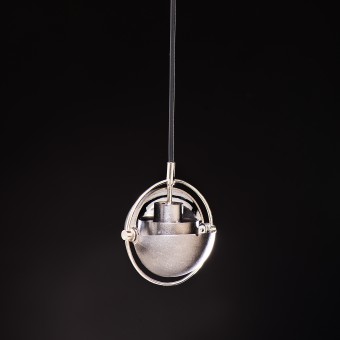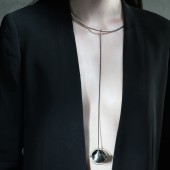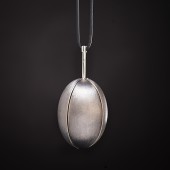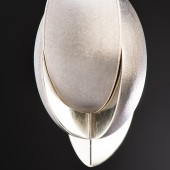
| THE AWARD |
| CATEGORIES |
| REGISTRATION |
| SUBMIT YOUR WORK |
| ENTRY INSTRUCTIONS |
| TERMS & CONDITIONS |
| PUBLICATIONS |
| DATES & FEES |
| METHODOLOGY |
| CONTACT |
| WINNERS |
| PRESS ROOM |
| GET INVOLVED |
| DESIGN PRIZE |
| DESIGN STORE |
| THE AWARD | JURY | CATEGORIES | REGISTRATION | PRESS | WINNERS | PUBLICATIONS | ENTRY INSTRUCTIONS |
Transforma Pendants by Ksenia Zagaynova |
Home > Winners > Design #70618 >Interview |
 |
|
FS: What is the main principle, idea and inspiration behind your design?
KZ: The main principle is interactivity, the idea was to create the mechanic transformable pieces one could interact with. The shapes of these pendants can be easy changed by moving their parts, thus a little bit new design can be achieved each time. Transforma collection designs are based on the pendant lights by well-known designers.
FS: What has been your main focus in designing this work? Especially what did you want to achieve?
KZ: My challenge was not only esthetical but also technological - creation of the relevant shape and mechanism in a small piece with an adequate weight.
FS: What are your future plans for this award winning design?
KZ: I would like to make them more accessible for users in terms of price so I'm planning to work on the technology process optimization.
FS: How long did it take you to design this particular concept?
KZ: It took me around 2 and a half months to create it: from research to production.
FS: Why did you design this particular concept? Was this design commissioned or did you decide to pursuit an inspiration?
KZ: I am constantly inspired by the simple forms and clear lines of the contemporary architectural and interior design objects. Namely the pendant lights often resemble jewelry artwork and that observation encouraged me to create a similar small object and try to place it in a totally different environment - a human body.
FS: Is your design being produced or used by another company, or do you plan to sell or lease the production rights or do you intent to produce your work yourself?
KZ: I'm planning to produce it myself with the help of a professional jeweler.
FS: What made you design this particular type of work?
KZ: I am constantly inspired by the simple forms and clear lines of the contemporary architectural and interior design objects. Namely the pendant lights often resemble jewelry artwork and that observation encouraged me to create a similar small object and try to place it in a totally different environment - a human body.
FS: Where there any other designs and/or designers that helped the influence the design of your work?
KZ: Lara Bohinc, Louis Weisdorf.
FS: Who is the target customer for his design?
KZ: I would say it is an intelligent, curious woman, aged 30 who wants to stand out and express her complicated personality by wearing something interesting and noticeable but still simple and clean.
FS: What sets this design apart from other similar or resembling concepts?
KZ: First of all, there're not so many interactive objects in jewelry design. And also I would say this design combines simplicity in shape and complexity in technology.
FS: How did you come up with the name for this design? What does it mean?
KZ: The name speaks for itself, it means something tat can be transformed.
FS: Which design tools did you use when you were working on this project?
KZ: These tools are research, drawing tools, 3D-modelling.
FS: What is the most unique aspect of your design?
KZ: This design is unique in terms technology, each piece contains a special mechanism that makes it transformable.
FS: Who did you collaborate with for this design? Did you work with people with technical / specialized skills?
KZ: Yes, in order to implement this project I worked with a professional jeweler.
FS: What is the role of technology in this particular design?
KZ: Technology plays an extremely important role here as without special mechanisms the idea wouldn't be achieved.
FS: Is your design influenced by data or analytical research in any way? What kind of research did you conduct for making this design?
KZ: I researched the lights created by different well-known designers, similar in shape and sometimes transformable.
FS: What are some of the challenges you faced during the design/realization of your concept?
KZ: The main challenge was to create a mechanism in a small piece with the adequate weight and dimensions.
FS: How did you decide to submit your design to an international design competition?
KZ: Our curator and designer, Igor Komov, in British Higher School of Art and Design inspired us to participate.
FS: What did you learn or how did you improve yourself during the designing of this work?
KZ: I improved my engineering skills meaning the calculation of the dimensions in small pieces and working on the mechanisms in cooperation with a professional jeweler and that also improved my ability to cooperate and bargain and control the production process.
FS: Any other things you would like to cover that have not been covered in these questions?
KZ: N/A
FS: Thank you for providing us with this opportunity to interview you.
A' Design Award and Competitions grants rights to press members and bloggers to use parts of this interview. This interview is provided as it is; DesignPRWire and A' Design Award and Competitions cannot be held responsible for the answers given by participating designers.
| SOCIAL |
| + Add to Likes / Favorites | Send to My Email | Comment | View Press-Release |




